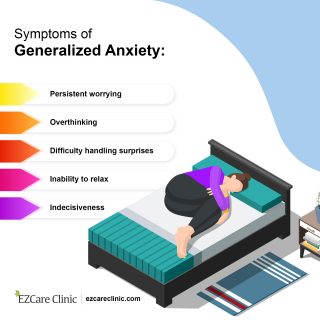Over the years, the anxiety prevalence has remained quite consistent. Generalized anxiety disorder (GAD) is a common type of anxiety, affecting a significant number of patients who have been diagnosed with anxiety.
Click the button below to get your anxiety diagnosed.
The figures also show that there are more women suffering from GAD than there are men.
Not your Everyday Worry
Everyone worries about any number of things on any given day. Whether it’s that deadline at work you have to beat, the pending bills you need to take care of, or if you will be able to make it in time for that social gathering, it is perfectly normal to feel a bit anxious at times.
But GD is more than your average worrying. While you may find yourself worrying about much of the same things that everyone does, if you have GAD, you’ll be taking it to the next level.
If you call a family member or friend and they don’t pick up your call or get back to you immediately, your mind will start playing out any set of scenarios to explain this. Is the person on the other end hurt and that’s why they can’t come to the phone? Perhaps, they are just ignoring you because they don’t like you as much anymore, and your relationship is in trouble?
That’s just an example of how having anxiety can fill you with a sense of worry, dread, and tension, even when there is no reason to justify these feelings. Unfortunately, the constant worrying stays on repeat, and you can’t shake off the thoughts, which may affect day-to-day activities and social interactions. This constant worrying puts a strain on your body, mind, and emotions.

Types of Anxiety
Diagnosing GAD
It is this strain that will manifest in a number of signs and symptoms. Mental health screening, which will include your physician’s assessment of your symptoms and how long you have experienced them, is the primary diagnostic method for AGD. Apart from the psychological questionnaire, your doctor will also rely on your detailed medical and family history, and if need be, a physical examination.
These symptoms vary from one person to the next and are often a combination of physical, behavioral, and emotional signs. The severity of how you experience these symptoms will often get worse during stressful times.
If you are experiencing severe anxiety symptoms- Click below to book a consultation with our mental health expert.
Here is a closer look at some of the more common symptoms and signs of GAD:
Physical Symptoms
AGD may affect your body in any one or a combination of the following ways
- Feeling tired all the time and general fatigue
- Excessive sweating
- Heart palpitations
- Nausea. Diarrhea and other problems with your digestive system
- Frequent urination
- Muscles becoming tense
- Body aches
- Restlessness and insomnia
Emotional and Cognitive Symptoms
- Worrying that is intrusive, persistent, and disruptive
- Inability to relax and live in the present
- Excessive overthinking and over planning, much like OCD
- Inability to concentrate
- Difficulty making decisions, for fear of making the wrong ones

Symptoms of Generalized Anxiety
Behavioral Symptoms
- Inability to relax and spend time alone
- Avoiding situations and setting that present possible triggers, including socializing with others
- Missing school or days on account of the physical and emotional symptoms
- Always putting things off, including plans with friends and family because of feeling overwhelmed
- Constantly looking to others for approval and assurance even it means changing how you behave
- Failing to complete tasks, or having to switch between tasks for lack of concentration
- Spending way more time to complete tasks for the same lack of concentration
- Doing and re-doing tasks over and over again as you seek perfection
GAD In Children
GAD can affect anyone, regardless of their age, and young children and teens are no exception. GAD manifests in children in more or less the same way it does in adults. Primary signs to keep an eye out for include the following
- Fears and uncertainties about the future and are often even far into the future when the child will have become an adult
- Intense self-criticism and always chasing after perfection
- a constant dread over a disaster happening, and always feeling like they are to blame for when bad things happen
- looking at any misfortunes or disasters and being convinced that the same thing will happen to them and it’s only a matter of time
- Feeling the need to constantly seek approval and reassurance from everyone, right from the parents, to their peers and teachers at school.
Children, and especially the younger ones, may not know better and will not see any of these signs and symptoms for what they are. It is, therefore, crucial that parents and guardians be particularly vigilant and take the necessary steps when they notice the signs.
Book a consultation with our mental health experts to get help with your anxiety.
Get Help
A combination of cognitive-behavioral therapy, medication, and lifestyle changes helps in the management and treatment of AGD. Book an appointment with EzCare Clinic’s qualified doctors for a diagnosis and treatment plan.





